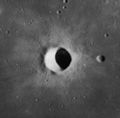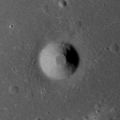 Lunar Orbiter 4 image | |
| Coordinates | 0°18′S26°36′W / 0.3°S 26.6°W |
|---|---|
| Diameter | 39 km |
| Depth | 3.1 km |
| Colongitude | 26° at sunrise |
| Eponym | Philippe van Lansberge |


Lansberg is a lunar impact crater on the Mare Insularum. It can be located by following a line south-southwest from Copernicus to Reinhold, then southwest to Lansberg. The crater has a high rim and a central mountain. There are terraces along the inner walls, and the tops have slumped to produce a sharp edge. This formation is not noticeably eroded, and there are no significant impact craters within the interior.
Contents
The crater is correctly spelled "Lansberg", but has sometimes been written "Landsberg" instead. It is named for the Belgian/Dutch astronomer Philippe van Lansberge. [1]
Lansberg is a crater of Upper (Late) Imbrian age. [2]
Approximately 40 km to the southeast of Lansberg is the landing site of the Luna 5 probe, and a further 60 km in the same direction is the landing site of Surveyor 3 and Apollo 12. [3]






